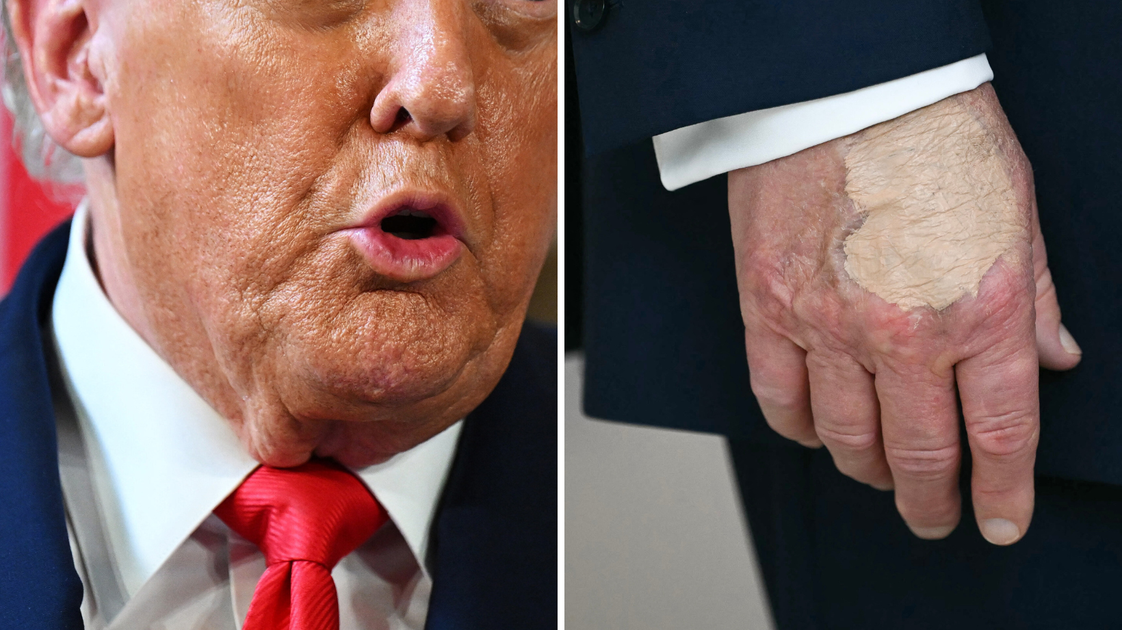
As fall makes its first appearance of 2025, it’s only natural to want to keep that sun-kissed glow into the chillier months. What’s not natural is the spray tan or body makeup used to achieve that look — unless that is, if you know how to color-match, blend and apply self-tanner correctly.
Let’s take, for example, these photos that demonstrate some challenging applications one may encounter with makeup and self-tanner:
Advertisement
Bryan Cantor, a celebrity makeup artist, hairstylist and groomer told HuffPost, “We see that the chosen foundation shade does not match his undertone (let alone his skin tone).”
Trina Eibon, the business manager of IONIQ, an at-home spray tan brand, told HuffPost that “even the most experienced people can run into small application hiccups.” Bright light and flash photography can magnify the errors and incorrect choice in the shade of tanner for your skin tone. She noted that in the photos seen here on this page, the face-neck mismatch is “one of the most common application errors when using traditional self-tanners that require manual blending.”
She also pointed out that the undertone drift toward orange can happen when a self-tanner doesn’t vibe with your skin pH. “Many conventional tanners don’t adapt to individual skin tones, which can lead to unnatural-looking results.”
Advertisement
Cantor noted that the face, neck and chest all “receive different amounts of sunlight and will usually be three different colors.” Therefore, he suggests matching to your chest and “using that shade on your face and neck to unify all three areas to the same skin tone.” He underscores the importance of blending makeup or tanner from the face onto the neck. “If your chest isn’t showing in your chosen outfit, then match it to your neck, or match to your face and blend your foundation onto your neck to ensure a natural-looking application,” Cantor told HuffPost.
It’s all in the blending — and not just for makeup
Cantor also observed that in these photos, it’s possible that self-tanner “has been applied poorly.” He recommends that when applying foundation or a self-tanner to your face area, “You should always be sure to blend it onto the ears and neck.”
Advertisement
For a flawless look, it’s critical to “be aware of your hairline if you are trying to deepen your skin tone with foundation or self-tanner,” according to Cantor. This is especially vital, he said, “if you have thin hair or a sparse hairline and you choose a much darker shade. There’s no way to tan your scalp, and you will have a clear line of demarcation between tanned and untanned skin.”
His go-to technique is to “use a big, dense makeup brush designed for buffing. I apply the product directly to the brush, tap the tanner across a portion of my face to ensure an even dispersal of product, and then buff it in.” Then he’ll go into the hairline and neck with an arched brush. Finally, as a last step for a natural look, “apply a light moisturizer to the ears beforehand and then use the brush to buff the tanner onto my ears.”
He told HuffPost this technique prevents uneven coloring, and keeps the self-tanner or makeup from accumulating “in the nooks and crannies and oddly-shaped parts of the ear, which would cause the tanner to process darker in those areas.”
Advertisement
Let’s talk about using concealer on your hands
According to Cantor, wearing makeup on your hands isn’t popular for a reason: “Hand makeup will transfer every time your hand comes in contact with clothes.”
Spot treating blemishes, bruises, age or liver spots on the hands is not something he recommends. “Using concealer to spot treat like this without addressing the surrounding skin will always look fake and noticeable. Some people who want to minimize age spots could use a transfer-proof body or leg foundation on their hands, but even this isn’t foolproof, as we use our hands so often for so many things that it will likely wear off pretty quickly.”
Advertisement
We all love the crispness of high-definition photography, and 4D tech necessitates a makeup artist who understands how skin, and skin makeup, reads on camera. “While this may have looked acceptable in person, it is glaringly obvious on camera,” Cantor explained.
If you insist on wearing hand makeup, Eibon suggests applying a transfer-proof leg makeup used to cover dark varicose veins. In terms of self-tanner, on the other hand, the key is to “use minimal product, feather across knuckles and between fingers and then clean nails and cuticles,” Eibon said.
20 Years OfFreeJournalism
Your SupportFuelsOur Mission
Your SupportFuelsOur Mission
For two decades, HuffPost has been fearless, unflinching, and relentless in pursuit of the truth. Support our mission to keep us around for the next 20 — we can’t do this without you.
We remain committed to providing you with the unflinching, fact-based journalism everyone deserves.
Thank you again for your support along the way. We’re truly grateful for readers like you! Your initial support helped get us here and bolstered our newsroom, which kept us strong during uncertain times. Now as we continue, we need your help more than ever. We hope you will join us once again.
We remain committed to providing you with the unflinching, fact-based journalism everyone deserves.
Thank you again for your support along the way. We’re truly grateful for readers like you! Your initial support helped get us here and bolstered our newsroom, which kept us strong during uncertain times. Now as we continue, we need your help more than ever. We hope you will join us once again.
Support HuffPost
Already contributed? Log in to hide these messages.



